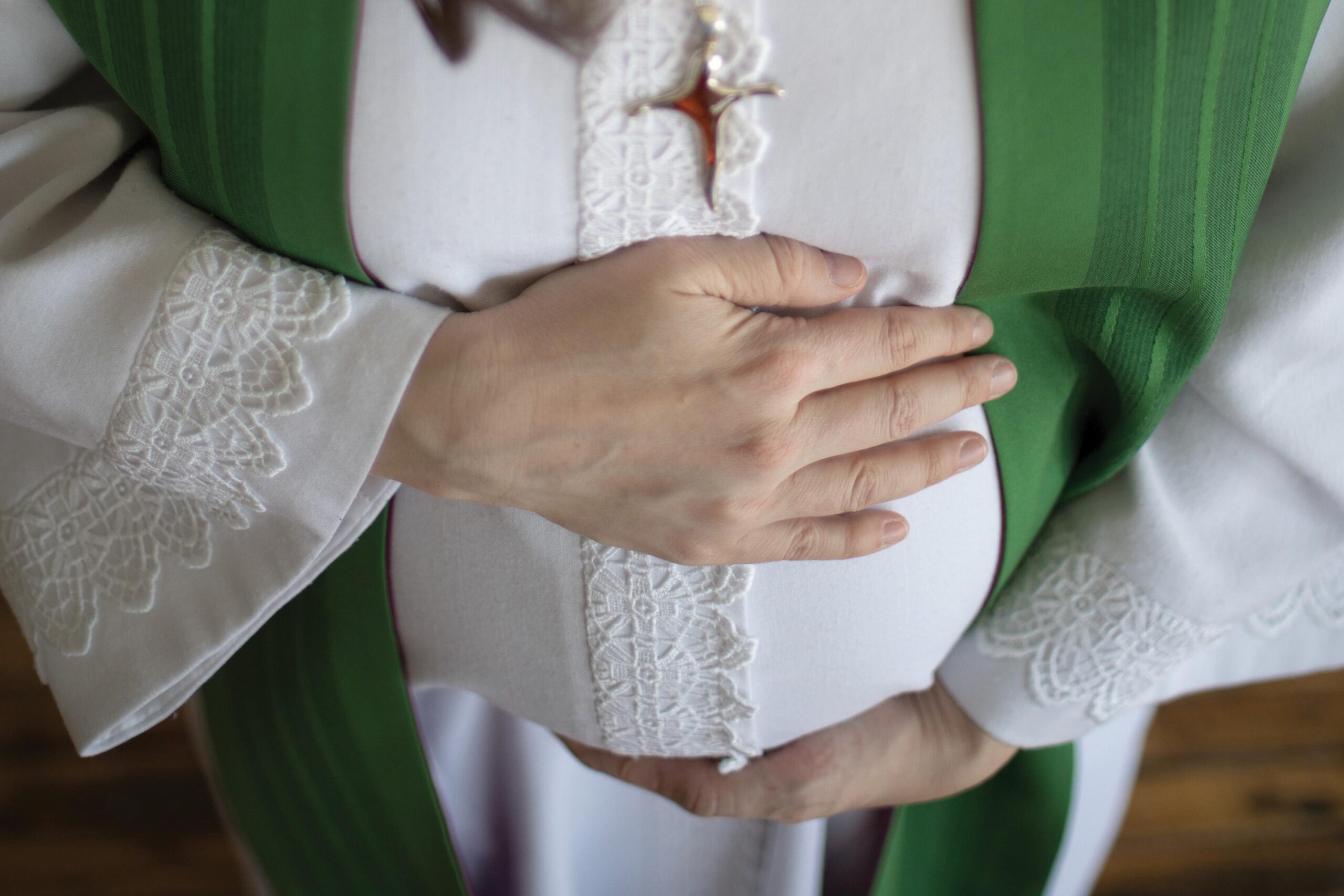The name Aidan means “fiery spirit.” We settled on the name during my high-risk pregnancy with our first son, reasoning that our baby must have a fiery spirit to survive so many threatened miscarriages. The congregations I served were exceptionally sup-portive through those roller-coaster months and afterward during my maternity and then parental leave.
I can’t say the same for the Presbytery. Unbeknownst to me, the Presbytery pastoral relations committee appointed my replacement for a full year without inquiring how long I intended to be away. When I got wind of the arrangement, I told the Presbytery that I didn’t want to be on leave that long. The response was that I had no choice because appointments are renewed annually and to offer less than a full year isn’t fair to the minister filling in. I argued that the Presbytery was acting unlawfully, but the response was unmoving. I called the incumbent minister who, thankfully, was understanding and flexible. We quietly came to an agreement. As it turned out, Aidan was colicky and screeched like a cat caught in a vice for six hours a day, and the prospect of church work never sounded so heavenly. I was back in the saddle after a few months.
You may unsubscribe from any of our newsletters at any time.
That was 15 years ago, before social media became ubiquitous. I was in my 20s, and I didn’t know any other young United Church ministers who had had babies while serving in ministry. It wasn’t easy to figure out what to expect of my church when I was expecting. And while I certainly wasn’t the first “minister mom” (that honour goes to Rev. Margaret Butler, in 1947), I still felt the burden and loneliness of being a pregnant woman in a traditionally male-dominated vocation.
Even today, many churches and ministers are ill-informed about how to manage and support a maternity leave — from the nuts and bolts of finding a supply and making financial arrangements, to knowing what conversations to have when planning a return to work. A healthy pastoral relationship hangs in the balance.
In Canada today (excluding Quebec, which has its own system), biological mothers are entitled to 15 weeks of maternity leave benefits. In addition, parents (of any gender) caring for a newborn or newly adopted child are eligible to take either the “standard” 35 weeks of parental leave or the “extended” 61 weeks (the weekly benefit rate drops accordingly). But knowing that ministers have the right to a maternity or parental leave doesn’t mean United Church congregations are always warm to the idea. And it’s not like church people have a lot of experience addressing them.
In 2016, there were only three combined maternity-parental leaves in the United Church; in 2017, just 10. The church doesn’t have readily available figures for maternity and parental leaves prior to 2016, and even now the statistics don’t distinguish between types of leaves or the gender of those taking them. More information is needed at all levels of the church to help both ministers and their congregations navigate the transition and avoid many of the misunderstandings that can arise.
Thirteen years ago, Rev. Sarah Miller was struggling with infertility, dreading the monthly discovery that she had once again failed to conceive. So it’s an understatement to say that Miller was elated to discover she was finally pregnant. But the joy wasn’t unanimously reciprocated.
“The men in leadership said that I shouldn’t take a whole year: ‘This is a real burden,’ they said. It was quite a wealthy church. They weren’t struggling. They weren’t isolated. . . . Even with the amount they topped up my salary, they saved money during that time. The budget actually said, ‘Financial burdens caused by Sarah’s maternity leave.’”
Miller’s heart sank when a congregant sent her a letter saying that it was wrong to bring a child into the world without a father. She was in a same-gender relationship at the time.
When she returned to work after having her daughter, Miller was told that she wasn’t really committed to her job because she took a full year’s leave. She left her position six weeks after returning.
Rev. Erin McIntyre’s return from leave was short-lived too. Over the phone, she nervously tells me that her goal in our conversation is to stay positive about a situation that was “not terribly positive.” At first, she says, her congregation received the news of her pregnancy well. “We would light candles and name prayers of thanksgiving and concern during the service. There was a time for everyone to add their prayers. [The pregnancy] was one I named. Folks were very excited at the beginning.”
While McIntyre was away on leave, though, the congregation discerned that it couldn’t afford full-time ministry. The first day she returned to work, she was notified that in three months, her position would be cut in half. Moreover, the half-time position required leadership each Sunday, which meant that it wouldn’t easily marry with another ministry job.
The main breadwinner, McIntyre had no choice but to take the position. “It was stressful,” she says. “Thank God we were in [a province] that had a child-care subsidy so I could get my son into daycare. At one point, I was very close to having to go to the food bank. We used milk coupons so there was at least free milk, and we had food stored up. My parents and in-laws helped out. . . . I felt like I had the rug pulled out from under me.”
There’s no denying that taking any kind of leave requires additional work and sometimes cost for the employer. Some churches adjust better than others, and there’s no guarantee that two leaves will be received the same way, even by the same congregation.
Rev. Nancy Nourse, now the minister at Northminster United in Calgary, had two maternity and parental leaves over the nine years she served in her settlement charge from 2002 to 2011. The two experiences were dramatically different. “I always say that my first maternity leave was a novelty, and the second was an inconvenience,” she says. “Some people really welcomed the babies, and we were given beautiful gifts, casseroles and hand-knit blankets for both pregnancies. Congregants generously offered childcare so my husband and I could enjoy a date night out. I did feel very loved and supported both times.”
But the second pregnancy, four years after the first, also had a different tone. This time, there was talk of financial strain and other grumbling. “That’s when comments like ‘The entitlement women have these days’ and ‘We’ll just hire a man next time’ surfaced. I would say, ‘Well you know, men can get these same parental-leave benefits.’ They were shocked,” says Nourse, adding, “It’s really just lack of information, education or understanding around what is available for all parents now.”
Both McIntyre and Nourse say that the pastoral relationship they returned to after their leave was no longer viable. McIntyre had trouble making ends meet financially, and Nourse says her absence allowed some in the congregation to fan the flames of discontent. Both ministers left their positions within a year.
Rev. Sarah Fanning, who had three babies between 2005 and 2014 while serving in ministry, offers up this advice to colleagues who are expecting: “Some congregations will be thrilled. Some congregations will be going, ‘We don’t know what to do.’ And some will be somewhere in between.” Whatever the situation, she counsels, you need to know what you are entitled to and have conversations about how engaged you are going to be with the congregation when you are on leave and expectations when you return to work.
Fanning’s advice is hard won. The first congregation set the bar high. “The UCW [United Church Women] said, ‘Okay, we are having a minister who is having a baby. How can we be supportive?’ . . . I went in with that same expectation in the second [pregnancy].”
Tragically, her second child — a girl — died shortly after birth. Some congregants felt strongly that since Fanning didn’t have a baby to look after, she should return to work right away. Maternity leaves are designed to allow a mother to recover physically and emotionally after giving birth. That’s why, by law, new biological mothers are entitled to maternity leave — regardless of whether the baby lives. While the chair of her personnel committee advocated for her leave benefits, the lack of compassion from other members of the congregation was one of the factors driving Fanning’s decision to move on.
Fanning’s third pregnancy was incredibly stressful, as the fear of losing another child consumed her. For its part, the congregation seemed to tiptoe around her leave plans, possibly to avoid triggering her anxiety. “I tried to maintain openness and transparency,” says Fanning. A healthy baby boy arrived, but the leave was rough. She and her congregation had discussed the core issues related to her departure such as making sure the work was covered, but they didn’t have conversations about more peripheral ones like whether she expected to bring the baby to church with her when she returned.
“While I was on leave, they told me that they wanted my son to be looked after at home on Sunday mornings [when I returned to work]. I was shocked, because that kind of came out of left field.” Eventually, Fanning paid a sitter to accompany her to church so that her child could have the experience of a church community. That wasn’t straightforward either. Other parents starting asking if they could leave their babies with the sitter she was personally paying.
Fanning longed to have her children grow up in a church with people they could consider spiritual grandparents or honorary aunts and uncles. Her vision quickly evaporated. She wound up on stress-induced medical leave six months after returning to work.
If the pastoral relationship isn’t solid, going on leave may exacerbate the challenges. Yet it can also serve to draw the congregation and minister closer together. I personally felt deeper attachment and affection with my congregations after I returned from my leave; they treated me with so much care and grace and welcomed the new baby with such generosity that I felt a strong urge to reciprocate the love.
Navigating parental leave means more than negotiating logistics; how congregations, ministers and the wider church approach a leave boils down to ethics and values. When staff are expecting, there is an opportunity for the church to model, in its employment practices and policies, the rich rewards that bearing, adopting and raising children bring. Nourse says that churches need to think about how well they value families and whether that translates into support for parents who want to stay home in the first months or year of a child’s life or adoption into a new family. “We are putting our values into action,” says Nourse. “What we want for our whole community, we also want for our churches and our staff.”
Sarah Miller says that the life experience she has gained through child loss and having children has helped her grow as a minister. “The experience of having a baby, through childbirth or adoption, is such an intense experience. Whatever life experience clergy have, it can be a gift to the people they minister to. . . . Congregations need to consider how [parental leave] can build up a relationship rather than defaulting to ‘You are an employee.’”














